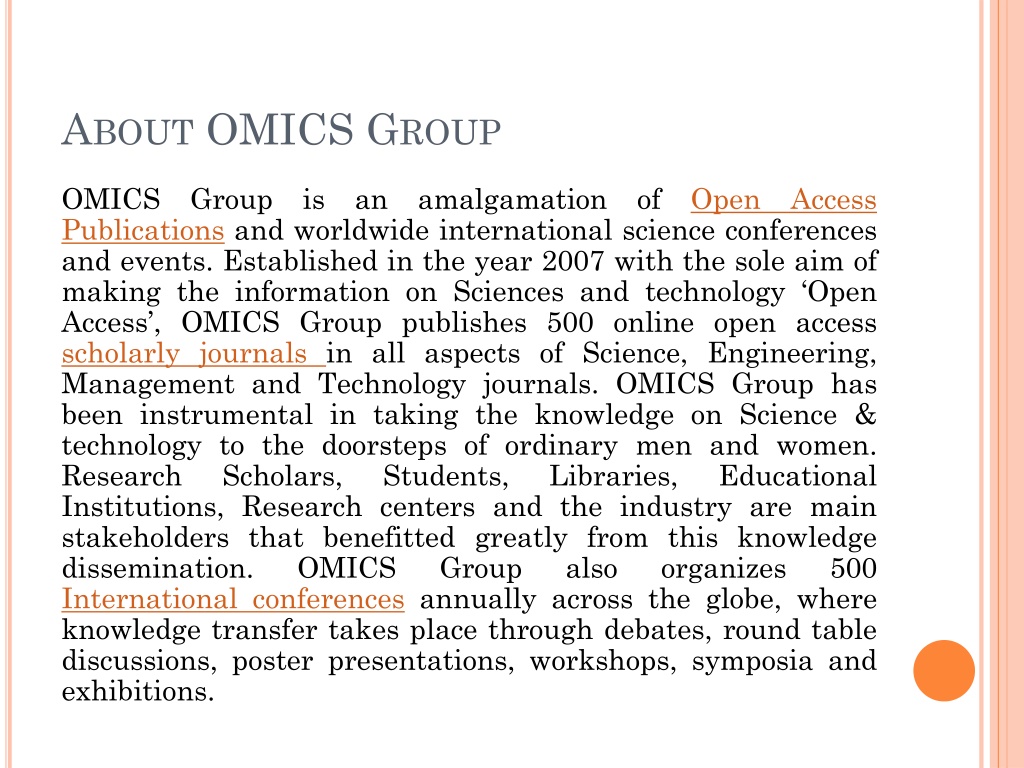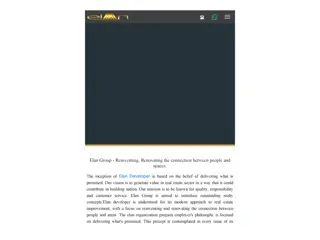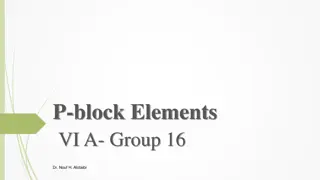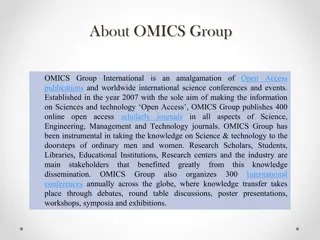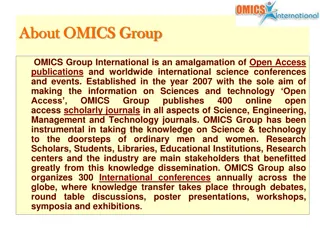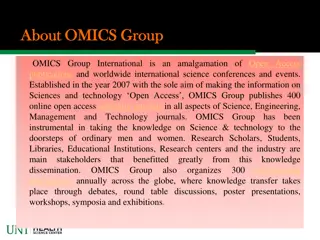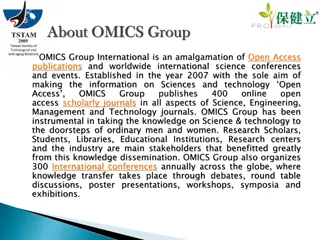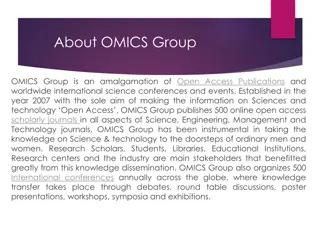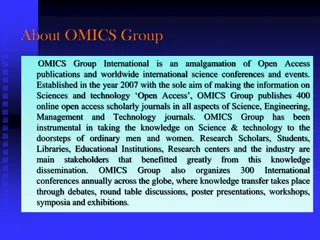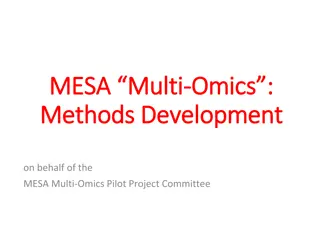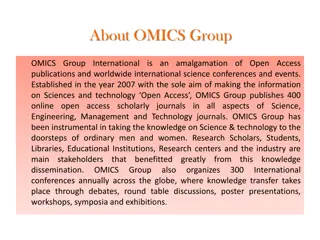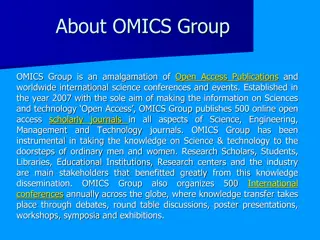ABOUT OMICS GROUP
OMICS Group, established in 2007, focuses on Open Access science and technology dissemination through 500 journals and 500 worldwide conferences annually. Benefiting research scholars, students, institutions, and the industry, OMICS Group facilitates knowledge transfer through debates, workshops, and exhibitions. Explore innovative research in various aspects of Science, Engineering, Management, and Technology with OMICS Group.
Download Presentation

Please find below an Image/Link to download the presentation.
The content on the website is provided AS IS for your information and personal use only. It may not be sold, licensed, or shared on other websites without obtaining consent from the author.If you encounter any issues during the download, it is possible that the publisher has removed the file from their server.
You are allowed to download the files provided on this website for personal or commercial use, subject to the condition that they are used lawfully. All files are the property of their respective owners.
The content on the website is provided AS IS for your information and personal use only. It may not be sold, licensed, or shared on other websites without obtaining consent from the author.
E N D
Presentation Transcript
ABOUT OMICS GROUP OMICS Publications and worldwide international science conferences and events. Established in the year 2007 with the sole aim of making the information on Sciences and technology Open Access , OMICS Group publishes 500 online open access scholarly journals in all aspects of Science, Engineering, Management and Technology journals. OMICS Group has been instrumental in taking the knowledge on Science & technology to the doorsteps of ordinary men and women. Research Scholars, Students, Institutions, Research centers and the industry are main stakeholders that benefitted greatly from this knowledge dissemination. OMICS Group International conferences annually across the globe, where knowledge transfer takes place through debates, round table discussions, poster presentations, workshops, symposia and exhibitions. Group is an amalgamation of Open Access Libraries, Educational also organizes 500
OMICS INTERNATIONAL CONFERENCES OMICS International is a pioneer and leading science event organizer, which publishes around 500 open access journals and conducts over 500 Medical, Clinical, Engineering, Life Sciences, conferences all over the globe annually with the support of more than 1000 scientific associations and 30,000 editorial board members and 3.5 million followers to its credit. Pharma scientific OMICS workshops and national symposiums across the major cities including San Francisco, Las Vegas, San Antonio, Omaha, Orlando, Raleigh, Philadelphia, Baltimore, United Kingdom, Valencia, Dubai, Beijing, Hyderabad, Bengaluru and Mumbai. Group has organized 500 conferences, Santa Clara, Chicago,
ANTI- INFLAMMATORY EFFECTS OF CANNABINOID 2 RECEPTOR AGONIST, GW405833, IN A MODEL OF CARRAGEENAN-INDUCED ACUTE INFLAMMATION OF THE RAT PAW Seyfullah Oktay Arslan, PhD Department of Pharmacology Yildirim Beyazit University, Faculty of Medicine From Ankara, T RK YE
OUR WORKNG TEAM Seyfullah Oktay Arslan, Yildirim Beyazit University Ali Parlar, Adiyaman University Muhammet Fatih Do an Yildirim Beyazit University Alper Yal n, Adiyaman University Mehmet Kaya zer Adiyaman Beyazit University
ANTI- INFLAMMATORYEFFECTSOFCANNABINOID 2 RECEPTOR AGONIST, GW405833, INAMODELOF CARRAGEENAN- INDUCED ACUTEINFLAMMATIONOFTHERATPAW Introduction Materials and Methods Results Discussion References
INTRODUCTON Cannabis sativa Synthetic Cannabinoids The receptors The ligands The enzymes The effect mechanism Endocanna binoidergic system (ECS) ECs and their effects Central Pheripferal ECs and Inflammation
INTRODUCTON THE CANNABINOIDERG CSYSTEM CANNAB S SAT VA Cannabis sativa produces over 80 cannabinoids 9-tetrahydrocannabinol (THC) was identified as the main bioactive constituent of cannabis, the main psychotropic constituent of marijuana. The psychological addiction resulting from the abuse of cannabis is the main concern limiting its therapeutic use. Nonpsychoactive compound; cannabidiol (CBD) and cannabinol (CBN)
THESYNTHETICCANNABINOIDS Naphthoylindoles (e.g., JWH-018, JWH-073, JWH-398). Naphthylmethylindoles. (e.g., JWH-175, JWH-195, JWH-197). Naphthoylpyrroles.(e.g., JWH-030, JWH-156, JWH-243). Naphthylmethylindenes (e.g., JWH-176). Phenylacetylindoles (i.e., benzoylindoles, e.g., JWH-250, JWH-253, JWH-313). Cyclohexylphenols (e.g., CP 47,497 and homologs of CP 47,497). Classical cannabinoids (e.g., HU-210).
INTRODUCTON THE CANNABINOIDERG CSYSTEM I. THE RECEPTORS The cannabinoid receptors were found and cloned in the early 1990s The endogenous cannabinoid (EC) system consists of two G-protein-coupled cannabinoid i.e. CB1 and CB2 receptors However there are maybe additional receptors And, some EC effects result from the interaction with other receptors, such as the vanilloid receptor
INTRODUCTON THE CANNABINOIDERG CSYSTEM I. THE RECEPTORS The cannabinoid CB1 receptors are preferentially located on brain and also expressed in nerve terminals of peripheral tissues including heart and vessels. The cannabinoid CB2 receptors are mainly located on peripheral non-neuronal cells (mostly immune system cells) which exert a broad range of critical effects under physiological or pathological conditions
INTRODUCTON THE CANNABINOIDERG CSYSTEM II. ENDOCANNAB NO D L GANDS First endogenous ligands turned out to be fatty acid-derived molecules including Anandamide (arachidonoyl ethanolamide, AEA) and 2-arachidonoylglycerol (2-AG) AEA has more affinity to CB1 than CB2, 2-AG shows similar affinity for CB1 and CB2 CB2 receptors may also bind other endocannabinoid ligands; however, the signalling consequences of this binding is poorly known
INTRODUCTON THE CANNABINOIDERG CSYSTEM III. ENDOCANNABINOID-B OSYNTHET C AND CATABOL CENZYMES Ca2+-dependent N-acyltranferase N-acylphosphatidylethanolamine- hydrolyzing phospholipase D AEA Fatty acid amide hydrolase (FAAH) diacylglycerol lipase phospholipase C 2-AG Monoacylglycerol lipase (MAGL)
INTRODUCTON THE CANNABINOIDERG CSYSTEM III. ENDOCANNABINOIDBIOSYNTHETICANDCATABOLICENZYMES The biosynthesis of AEA is catalyzed by Ca2+- dependent N-acyl-phosphatidylethanolamine hydrolyzing phospholipase D, AEA can also be produced by other routes, AEA is hydrolyzed mainly by fatty acid amide hydrolase (FAAH) into arachidonic acid and ethanolamine .
INTRODUCTON THE CANNABINOIDERG CSYSTEM III. ENDOCANNABINOIDBIOSYNTHETICANDCATABOLICENZYMES 2-AG is synthesized from its phospholipid precursor diacylglycerol by diacylglycerol lipases. Phospholipase C- releases diacylglycerol (DAG) from phosphatidylinositol-4,5-bisphosphate, which in turn is metabolized by diacylglycerol lipases (DAGLs) with DAGL and DAGL having prevalent roles in the brain and in several peripheral tissues, respectively to produce 2-AG. The major degradative or inactivated pathway of 2-AG is its hydrolysis to arachidonic acid and glycerol by monoacylglycerol lipase (MAGL)
INTRODUCTON THE CANNABINOIDERG CSYSTEM III. ENDOCANNABINOIDBIOSYNTHETICANDCATABOLICENZYMES Although the hydrolysis pathway seems to be the primary fate of AEA and 2-AG, they can also be oxidized by cyclooxygenase-2 and lipoxygenase isozymes, thus producing oxidized endocannabinoids, which are involved in regulating brain synaptic transmission and other biological processes
INTRODUCTON THE CANNABINOIDERG CSYSTEM THE EFFECTS Accumulating evidence has indicated that EC and their major receptors CB1 and CB2 play a major role in the pathophysiology of diseases at a preclinical stage, the selective CB2 molecules are increased to interest as new targets in drug discovery Endocannabinoids can modulate levels of proinflammatory mediators and immune cell migration. Exogenously administered 2-AG and anandamide or several selective agonists to animal models of inflammation have also shown to be effective.
INTRODUCTON THE CANNABINOIDERG CSYSTEM THE EFFECTS ECs are provided by a series of central and peripheral effects CB1 is more responsive to psychoactive cannabinoids (eg, THC) than to nonpsychoactive cannabinoids (eg, cannabidiol)
INTRODUCTON THE CANNABINOIDERG CSYSTEM THE EFFECTS ECs influence analgesia and motor function, energy balance and food intake, cardiovascular function, immune and inflammatory responses, and cell proliferation
INTRODUCTON THE CANNABINOIDERG CSYSTEM AND INFLAMMAT ON the endocannabinoid system has been found to be involved in many inflammation-related conditions, such as Multiple sclerosis, Atherosclerosis, Inflammatory bowel disease, RA, Sepsis, and Allergic inflammation
INTRODUCTON THE CANNABINOIDERG CSYSTEM AND INFLAMMAT ON The blockage of CB1 and activation of CB2 could inhibit inflammation in various animal models, mainly through restraining the activity of the immune system. The exogenous application of AEA and 2-AG exerts anti- inflammatory effects by decreasing the production of inflammatory mediators. The exogenous application of selective CB2 agonists exerts anti-inflammatory effects by decreasing the production of inflammatory mediators. Upregulating the level of endogenous cannabinoids by inhibiting their common metabolic enzyme, becomes an important strategy in the treatment process of inflammation-related diseases
INTRODUCTON INOURPREVIOUSSTUDIES We had evaluated some effects of the cannabinoid (CB)2 receptor activations during the inflammatory processes of peripheral tissues after intestinal ischemia/reperfusion .
INTRODUCTON A M OF TH S STUDY This study was designed to investigate the anti- inflammatory effects of selective CB2 receptor agonist, GW405833, in the carrageenan paw oedema test of rats. in the capsaicin paw oedema test of rats.
MATERALS AND METHODS AN MALS AND EXPER MENTAL DES GN The subjects weighed between 200 and 250g, and were housed in a temperature (20 22 C) in their home cages and were maintained on a 12/12 h light/dark cycle. All rats were given standard rat chow and water ad libitum The sample size for each treatment group was 6 to 8 mice/group All animal protocols were approved by the Institutional Animal Care and Use Committee and were in accordance with the National Institutes of Health Guide for the care and use of Laboratory animals. After testing was completed, all mice were humanely euthanized via CO2 asphyxia, followed by rapid cervical dislocation.
MATERALS AND METHODS INFLAMMATION TYPE Carrageenan-induced paw edema - Mix type of inflammation were induced by giving an intraplantar injection of carrageneen (50 l, 1%) or Capsaicin-induced paw edema - Neurogenic type of inflammation were induced by giving an intraplantar injection of capsaicin (50 l, 0.1%) into the paw
MATERALS AND METHODS INFLAMMATION TYPE PAW EDEMA Edema was expressed as the increase in paw thickness (mm) after carrageenan injection relative to the pre- injection value for each animal. Paw thickness was measured with electronic digital calipers, prior to and 1 or 4 h following capsaicin or carrageenan administration respectively, which corresponds to peak edema time.
MATERALS AND METHODS AN MALS AND EXPER MENTAL DES GN In the first group, Plasma extravasations were measured via Evans blue dye method. The dye was injected in the tail vein 15 min before the end of the experiments. The anaesthetized animals were sacrificed by decapitation, and hind paws were incubated with formamide, and then the extracted dye was measured by spectrophotometry at 620 nm.
MATERALS AND METHODS AN MALS AND EXPER MENTAL DES GN In the second group, paw thickness was measured with electronic digital callipers, prior to and 4 h following carrageenan or 1 h following capsaicin administration, which corresponds to peak oedema.This procedure has been used previously by studies. The anti-oedematous effects of GW405833 (3 mg/kg, i.v.) were compared to diclofenac (10 mg/kg, i.v.), a nonselective cyclooxygenase inhibitor, 15 min before these intraplantar injections of inflammatory agents. CB receptor involvement in the anti-inflammatory effects of GW405833 was evaluated by administration of the CB2 receptor antagonist, AM630 (1 mg/kg, i.v., 5 min before CB2 agonist injection).
MATERALS AND METHODS STAT ST CAL DATA ANALYS S All statistical analyses were carried out using GraphPad statistical software. All data were presented as mean standard error mean. Difference between groups was compared using student t test or one-way ANOVA followed by Tukey's Multiple Comparison. P <0.05 was considered significant.
RESULTS I. The carrageenan-induced paw oedema Administrate of carrageenan caused clear edema in paw tissue (P < 0.001) Pretreatment of rats with both GW405833 (P < 0.05) and diclofenac (P < 0.001) significantly attenuated carrageenan-induced paw oedema compared to vehicle- treated group. CB2 receptor antagonist, AM630, significantly reversed the effect of CB2 agonist (P < 0.01)
Figure 1. The carrageenan-induced paw oedema and the effect of CB2 agonist C ontrol C a rre +D iclo 9 C arre+C B 2 A g C arre+C B 2 A nta 8 C arre+D M S O 7 **** C a rre C arre+C B 2 A g+A nta P aw Thickness (m m ) 6 5 4 3 2 1 0 -1 0 1 2 3 4 5 T im e (h )
RESULTS II. The capsaicin-induced paw oedema Administrate of capsaicin caused clear edema in paw tissue (P < 0.001) Pretreatment of rats with GW405833 (P < 0.001) significantly attenuated capsaicin-induced paw oedema compared to vehicle-treated group. CB2 receptor antagonist, AM630, significantly reversed that effect (P < 0.001)
Figure 2. The capsaicin-induced paw oedema and the effect of CB2 agonist C ontrol C apsaicin+D iclo 9 C apsaicin+C B 2 A g C apsaicin+C B 2 A nta 8 C apsaicin+V ehicle 7 C apsaicin *** C apsaic+C B 2 A g+A nta P a w Th ickn ess (m m ) 6 5 4 3 2 1 0 -1 0 1 2 T im e (h )
RESULTS III. The effect of CB2 agonist on plasma extravasation in carrageenan-induced paw oedema The GW405833 significantly inhibited plasma extravasation in carrageenan-induced paw oedema (P < 0.001) . Diclofenac inhibited also plasma extravasation, but has effect as more week (P < 0.05) CB2 receptor antagonist, AM630, significantly reversed the effect of CB2 agonist (P < 0.01)
Figure 3. The carrageenan-induced inflammation in paw tissue and the effect of CB2 agonist on plasma extravasation a*** c** 15 C ontrol E B g /g in dry tissue b* C arre C arre+D iclo 10 C arre+C B 2 A g b*** C arre+C B 2 A nta C arre+C B 2 A g+A nta 5 C arre+D M SO 0 C ontrol C arre+C B 2 A g C arre+C B 2 A nta C arre+C B 2 A g+A nta C arre+D iclo C arre C arre+D M S O
RESULTS IV. The effect of CB2 agonist on plasma extravasation in capsaicin-induced paw inflammation The GW405833 strongly inhibited plasma extravasation in capsaicin-induced the neurogenic inflammation in paw tissue (P < 0.001). Diclofenac not inhibited plasma extravasation (P > 0.05) CB2 receptor antagonist, AM630, significantly reversed the effect of CB2 agonist (P < 0.001)
Figure 4. The capsaicin-induced neurogenic inflammation and the effect of CB2 agonist on plasma extravasation 20 a*** C ontrol E B g /g in dry tissue c*** bns C apsaicin C apsaicin+D iclo C apsaicin+C B 2 A g 10 b*** C apsaicin+C B 2 A nta C apsaic+C B 2 A g+A nta C apsaicin+V ehicle 0 C ontrol C apsaicin+C B 2 A nta C apsaicin+V ehicle C apsaicin+C B 2 A g C apsaic+C B 2 A g+A nta C apsaicin+D iclo C apsaicin
DSCUSSON GW405833 significantly decreased the plasma extravasations in both carrageenan-induced mix type inflammation and capsaicin-induced neurogenic inflammation of rat paw. The pretreatment with AM630 clearly reversed the effects of GW405833, which suggests a significant interaction between GW405833 and AM630. So CB2 receptors mediate the anti-oedematous and anti- plasma extravasations effects of GW405833.
DSCUSSON The present study increases the understanding that pharmacological level of CB2 agonist plays on anti- inflammatory effects by demonstrating that GW405833 reduces capsaicin or carrageenan-induced paw edema. These effects were similar in magnitude to those produced by the CB2 agonist GW405833, as well as the nonselective COX inhibitor diclofenac.
The anti-edematous effects of GW405833 were mediated through CB2 receptors. CB2 antagonist, AM630, reversed these anti- edema effects.
These results suggest that the GW405833 reduces inflammation through the activation of CB2 receptors when administered after carrageenan, and that effect seems to be related to the suppression of neurogenic inflammation.
FINALLY The stimulation of CB2 receptors induces anti- inflammatory effects in several experimental conditions Our experimental studies provide evidence that supports the hypothesis for the activation of CB2 receptors may have beneficial effects against inflammatory processes, maybe via and related the control of neurogenic inflammation
REFERENCES RECENT PAPERS Huan Gui, Qiang Tong , Wenchun Quc, Chen-Mei Mao, Sheng-Ming Dai. The endocannabinoid system and its therapeutic implications in rheumatoid arthritis. International Immunopharmacology 26 (2015) 86 91. Mireille Alhouayek, Julien Masquelier and Giulio G. Muccioli. Controlling 2-arachidonoylglycerol metabolism as an anti-inflammatory strategy. Drug Discovery Today Volume 19, Number 3 March 2014 . Sudeshna Ghosha, Laura E. Wisea, Yugang Chenb, Ramesh Gujjarb, Anu Mahadevanb, Benjamin F. Cravattc, and Aron H. Lichtmana, The monoacylglycerol lipase inhibitor JZL184 suppresses inflammatory pain in the mouse carrageenan model. Life Sci. 2013 March 19; 92(0): 498 505. Renger Witkamp and Jocelijn Meijerink. The endocannabinoid system: an emerging key player in inflammation. Curr Opin Clin Nutr Metab Care 2014, 17:130 138. Slava Rom and Yuri Persidsky. Cannabinoid receptor 2: Potential role in immunomodulation and neuroinflammation Review. Neuroimmune Pharmacol. 2013 June ; 8(3): 608 620.
LETUSMEETAGAIN.. We welcome you all to our future conferences of OMICS International 3rd World Congress on Pharmacology On August 08-10, 2016 at Birmingham, UK http://pharmacology.pharmaceuticalconferences.com//
